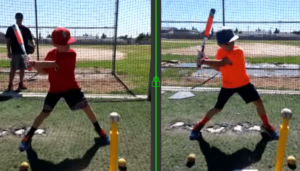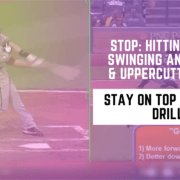Stop Hitting Pop-ups, Why Swinging Under And Missing, & Fix Uppercut Swing By Staying On Top Of Baseball Or Softball Drills
Learn how to STOP hitting pop-ups, why are you swinging under and missing, and drills on how to fix an uppercut swing by staying on top of the baseball or softball.
Paul Goldschmidt: Can a Bleeding Barrel Kill Hitting Potential?

My 9yo hitter Collin bleeding his barrel. Swings are synced, before (on the left) & after (on the right)
In this video, we’ll look at 2013 National League MVP runner up Paul Goldschmidt’s swing and relate it to one of my younger hitters. We’ll talk about:
- What is a bleeding barrel (1-week before & after case study),
- The “Goldy” standard, and
- How-to fix a bleeding barrel at home.
What is a “Bleeding Barrel” (1-week before & after case study)
I’ve been working on this with one of my young hitters, Collin. Bleeding the barrel is when the barrel starts to launch (turn into the hitting zone) before the hitter’s front foot touches down.
It’s caused by a premature turning of the shoulders, and is very inefficient when it comes to transferring energy. In order to load powerful springy fascia and connective tissue in the torso, the front shoulder must stay in and down towards the back hip, at front foot touch down. CLICK HERE for similar analysis comparing Josh Donaldson (Oakland A’s) to Jose Bautista (Toronto Blue Jays).
The week following my young hitter Collin’s AFTER video, he was bleeding his barrel again. The cause? His dad said a coach was doing rapid-fire soft toss before games. Needless to say, Collin’s dad had a talk with the coach.
SCIENCE-BASED TRAINING:
Improve your hitting strategy dramatically by applying human movement principles.
Learn not only how and what to train but also the science behind the methods.
The “Goldy” Standard
Notice Paul Goldschmidt (pictured to the right) at front foot touch down:
- His barrel angle is up (70-degree angle), and
- He’s showing his numbers to the pitcher (see video above).
Most importantly, taking care of point #2 above will stop the bleeding barrel.
Can Paul Goldschmidt do better? According to Baseball-Reference.com, he stands at 6’3″, and weighs 245 lbs. With this line, he can get away with inefficient mechanics and still hit for decent power. His average home-run total per 162-game season is only 29. For how big he is, he can average over 40 homers per season.
Here are a couple things I’d love to see change in Goldy’s swing:
- More forward momentum,
- Better down shoulder angle (side bending in the spine),
- Hide his hands a little more from the pitcher, and
- Extend up and back over the catcher more (he was a little out front on this pitch).
How-To Fix a Bleeding Barrel at Home
Remember to use Variance in the following scenario. Three steps to stop the bleeding barrel:
- Break Swing into 2-Steps (1-2 second pause between): 1) Fight Position (landing), and 2) Final Turn – focus on showing the hitter’s numbers to the pitcher at the Fight Position, and keep a barrel angle around 45-55 degrees.
- Check-Swing Drill – get hitter to show they can keep from bleeding the barrel to impact.
- Put Swing Together – once they get here, then progress them from tee, to soft toss, to LIVE batting practice. If they can hold together their mechanics, then the brain has ingrained the movement.
CLICK HERE to get more information on my online hitting lessons program The Feedback Lab.
- Fix Your Child’s Fear of the Ball Fast: Proven Hitting Drills to Stop Flinching at Pitches—Trusted by Top Youth Baseball Coaches - July 12, 2025
- Fix Your Little Leaguer’s Hitting Slump Fast – Proven Confidence Drills & Mental Reset Tools (Used by Top Youth Baseball Coaches) - July 9, 2025
- Best Hitting Drills for 8-Year-Olds (2025): Fix Swing Flaws Fast with This MLB-Trusted Youth Baseball System—At-Home, Step-by-Step, and Built for Game-Day Confidence - July 5, 2025













Good work Joey. I like the drills you showed at the end. Getting the player to divide their swing up in two parts (pre heel plant, and post heel plant) is an excellent idea. The whole concept of the ‘bleeding barrel’ is a good one. Another thing to consider is that if you start that barrel around too early, you’re going to have to make up that time later – you only have X amount of time, and space, to get the bat around and connect with the ball. On an inside pitch (or anything that you are trying to pull), you are going to hit the ball out in front of you In front of your front foot), which means the bat gets to travel further to contact. But on anything you are letting get deeper on you, there is less time and distance from launch to contact. The last thing you want to do is diminish this time and space by letting the bat come passively through the zone. That’s the reason it’s harder to hit with power OP – the bat doesn’t go as far and has to go from launch to contact in less time, so you can’t generate the same bat speed. Guys that bleed the barrel and try to sit on pitches are basically bunting. They may get away with it with these tin bats that can flip a little Texas League Special out of the infield, but if they try that with wood …
Thanks for the comment Bob! Yes, I agree. And Collin felt like he couldn’t hit his way out of a wet paper bag until we stabilized the “bleeding”. I worked with him yesterday and his dad said he hit one 220 feet!! First time for him, and at 9 years old no less. Now, we’re trying to get him to be more consistent with that. Next week’s video blog will be an ode to Tony Gwynn, and discuss how Tony could’ve hit for more repeatable power, like Ted Williams wanted to see in their conversation together in 1994, I believe.
Gee Joey! That’s a pretty sweet swing you have there. If I was pitching to you, I’d have to be careful not to throw my famous ‘Steak Ball’ … It’s big and juicy, I serve it up on a platter, and as soon as you see it you want to cut right through the middle of it. I watched that Ted Williams Tony Gwynn bit, and Ted did say he thought Tony could have hit harder. Both great guys!
Haha, thanks Bob! It can always be better. Next week’s article will go into that. It’s too bad Ted Williams didn’t have access to this human movement science stuff. He would have LOVED it!
This is fantastic
Glad you like it Mike =)
Joey,
Great job with dissecting a very common problem. As always you hit it right on the head. Early shoulder rotation before heel strike results in losing a potentially powerful angle necessary for applying torque with the hands. Sequentially this early release causes the hitter a significant barrel speed loss and I believe that directional force is also altered. In the Diamond Kinetics system that I use, Max Acceleration is an area of focus that I try to improve upon with my high level hitters as well as their Time to Impact measures. I have seen a Bleeding Barrel result in a 5 to 10 mph loss of Barrel speeds. Well done and keep up the great work!
Coach DeLong
Thanks Coach DeLong, I appreciate the support. Glad to have you on board 😀
Joey, I hope you were trying to hit that pitch the other way off the tee, otherwise you got beat! lol
Haha Paul…right on!